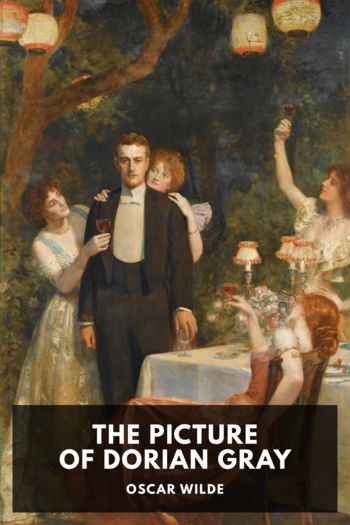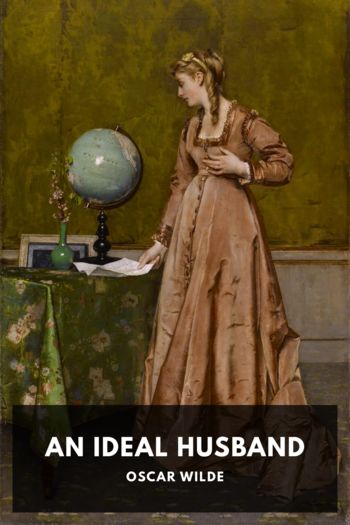The Picture of Dorian Gray by Oscar Wilde (top ebook reader TXT) 📕

Description
The Picture of Dorian Gray was first published as a serial in Lippencott’s Monthly Magazine, and the publishers thought it would so offend readers that they removed nearly 500 words without Wilde’s approval. Wilde soon expanded it and republished it as a novel, including a short preface justifying his art. Even though his contemporaries considered it so offensive that some argued for his prosecution, Dorian Gray today survives as a classic philosophical novel that explores themes of aestheticism and double lives. Couched in Wilde’s trademark cutting wit, Dorian Gray is still being adapted today, with Dorian and his moldering portrait remaining cultural touchstones.
Read free book «The Picture of Dorian Gray by Oscar Wilde (top ebook reader TXT) 📕» - read online or download for free at americanlibrarybooks.com
- Author: Oscar Wilde
Read book online «The Picture of Dorian Gray by Oscar Wilde (top ebook reader TXT) 📕». Author - Oscar Wilde
On one occasion he took up the study of jewels, and appeared at a costume ball as Anne de Joyeuse, Admiral of France, in a dress covered with five hundred and sixty pearls. This taste enthralled him for years, and, indeed, may be said never to have left him. He would often spend a whole day settling and resettling in their cases the various stones that he had collected, such as the olive-green chrysoberyl that turns red by lamplight, the cymophane with its wirelike line of silver, the pistachio-coloured peridot, rose-pink and wine-yellow topazes, carbuncles of fiery scarlet with tremulous, four-rayed stars, flame-red cinnamon-stones, orange and violet spinels, and amethysts with their alternate layers of ruby and sapphire. He loved the red gold of the sunstone, and the moonstone’s pearly whiteness, and the broken rainbow of the milky opal. He procured from Amsterdam three emeralds of extraordinary size and richness of colour, and had a turquoise de la vieille roche that was the envy of all the connoisseurs.
He discovered wonderful stories, also, about jewels. In Alphonso’s Clericalis Disciplina a serpent was mentioned with eyes of real jacinth, and in the romantic history of Alexander, the Conqueror of Emathia was said to have found in the vale of Jordan snakes “with collars of real emeralds growing on their backs.” There was a gem in the brain of the dragon, Philostratus told us, and “by the exhibition of golden letters and a scarlet robe” the monster could be thrown into a magical sleep and slain. According to the great alchemist, Pierre de Boniface, the diamond rendered a man invisible, and the agate of India made him eloquent. The cornelian appeased anger, and the hyacinth provoked sleep, and the amethyst drove away the fumes of wine. The garnet cast out demons, and the hydropicus deprived the moon of her colour. The selenite waxed and waned with the moon, and the meloceus, that discovers thieves, could be affected only by the blood of kids. Leonardus Camillus had seen a white stone taken from the brain of a newly killed toad, that was a certain antidote against poison. The bezoar, that was found in the heart of the Arabian deer, was a charm that could cure the plague. In the nests of Arabian birds was the aspilates, that, according to Democritus, kept the wearer from any danger by fire.
The King of Ceilan rode through his city with a large ruby in his hand, as the ceremony of his coronation. The gates of the palace of John the Priest were “made of sardius, with the horn of the horned snake inwrought, so that no man might bring poison within.” Over the gable were “two golden apples, in which were two carbuncles,” so that the gold might shine by day and the carbuncles by night. In Lodge’s strange romance A Margarite of America, it was stated that in the chamber of the queen one could behold “all the chaste ladies of the world, inchased out of silver, looking through fair mirrours of chrysolites, carbuncles, sapphires, and greene emeraults.” Marco Polo had seen the inhabitants of Zipangu place rose-coloured pearls in the mouths of the dead. A sea-monster had been enamoured of the pearl that the diver brought to King Perozes, and had slain the thief, and mourned for seven moons over its loss. When the Huns lured the king into the great pit, he flung it away—Procopius tells the story—nor was it ever found again, though the Emperor Anastasius offered five hundredweight of gold pieces for it. The King of Malabar had shown to a certain Venetian a rosary of three hundred and four pearls, one for every god that he worshipped.
When the Duke de Valentinois, son of Alexander VI, visited Louis XII of France, his horse was loaded with gold leaves, according to Brantome, and his cap had double rows of rubies that threw out a great light. Charles





Comments (0)